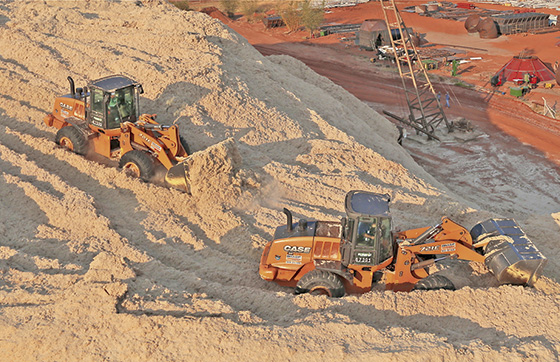Turned on demand

With the economy in crisis, players that work in the area bet in the attendance of clients’ needs as its strategy to attract them and to ensure their sales.
Going in the opposite direction of the industry of earthmoving machines—whose sales had a drop of 12.7 percent in 2014, according to the Sobratema Study of Brazilian Market of Construction Equipment 2014-2015—the market of wheel loaders increased 5.2 percent in that period, going from 5800 to 6100 units sold.
In 2015, however, the situation is quite different: this market is also involved in the economic crisis that the country is crossing. According to Sobratema’s survey, the niche of loaders may close the year with the second largest drop, reaching -23 percent and losing only for the market of motor graders, which had a reduction of 53.8 percent.
These data, however, may be considered optimistic if compared to figures referred to the first half of this year and to what some manufacturers are foreseeing. “From January to May, the market of wheel loaders had a drop of approximately 45 percent in comparison with the same period of 2014”, says Ricardo Zurita, earthmoving equipment sales manager of Liebherr, using data from the Committee for European Construction Equipment (Cece), which has Sobratema as its partner in Brazil. “Therefore, the deceleration of the market for this type of equipment is clear and was confirmed with opinions received from clients and other suppliers.”
Of course this situation did not come suddenly. As recorded in the study, Brazilian economy is decelerating since 2011. The consequences were felt hardly just now because—as says Zurita—“due to their productive structure, machine buying markets are slower to decelerate and also to accelerate again after the first safe signals”. Therefore, what was seen in 2014 and is becoming more serious in 2015 “is the result of this deceleration, this erratic motion of the economy during the last years, reinforced by the international crisis”.
CARE
For some manufacturers, the deceleration in the market of loaders—and of most equipment of the Yellow Line—results also of recent events. “Part of the decrease that is occurring in the sales is due to the political and economic situation that we are going through and part is due to the lack of delivery to the Ministry of Agrarian Development this year”, says Carlos França, marketing manager of Case CE for Latin America. “In 2014, total sales were of approximately 3500 machines. Since those sales were finished, the total of units sold in 2015 will be around 3000.”
Data of Sobratema Study are different. According to its survey, the Ministry bought 431 loaders in 2013 and 919 in 2014, a total of 1410 machines in both years. Anyhow, manufacturers were benefitted with government purchases. According to the research, 4.93 billion reais were injected this way in the industry. Therefore, it is “undeniable that without these government purchases, the Brazilian market of construction equipment would be reduced in 2013, instead of increasing, and the drop in 2014 would be even larger”, says França.
Before this scenario, expectations for the next months are careful. For some manufacturers a steady market would be a good situation. “For 2015, we expect that the decrease would not be sharper”, says Zurita. “We hope that the industry give us signals of recovering in this second half, signalizing an inversion of the current trend.”
For 2016, the expert believes in a slow start with possible recovering in the second half because the necessity of investments in infrastructure has to be maintained. “To estimate demands in medium and long term in Brazil is particularly challenging due to current politic and economic uncertainties”, says him.
But there are also some optimistic expectations among the manufacturers. This is the case, for example, of Marcos Rocha, product marketing manager of New Holland Construction for Latin America. He remembers that in 2014 the area of loaders was the second largest market of construction equipment. For 2015, the expectation is that it will remain among the three families with more sales in the area, together with backhoes and excavators. “This is being a challenging year, but we believe that this turbulence will stop soon”, adds him. “And a slower first half was already expected.”

Av. Francisco Matarazzo, 404 Cj. 701/703 Água Branca - CEP 05001-000 São Paulo/SP
Telefone (11) 3662-4159
© Sobratema. A reprodução do conteúdo total ou parcial é autorizada, desde que citada a fonte. Política de privacidade














